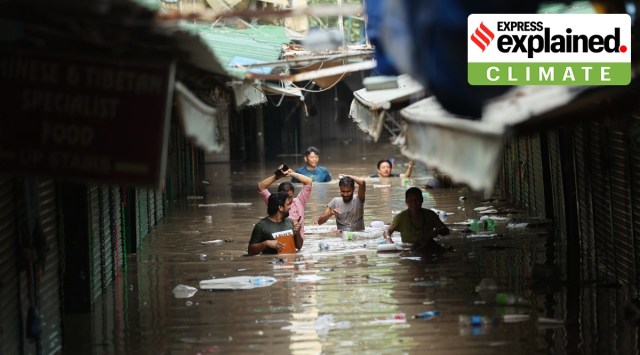How incessant rains in North India led to rising Yamuna level
Northwest India has seen heavy rainfall from Saturday, including in the basin states of the Yamuna. This has led to Delhi CM Arvind Kejriwal requesting Union Home Minister Amit Shah that water from Hathnikund barrage be released at a controlled speed. Here's why.
 People wade through a submerged Monastery Budha Vihar Market, after waters in the Yamuna rose to its highest recorded levels in New Delhi on Wednesday. (Express Photo by Tashi Tobgyal)
People wade through a submerged Monastery Budha Vihar Market, after waters in the Yamuna rose to its highest recorded levels in New Delhi on Wednesday. (Express Photo by Tashi Tobgyal) The Yamuna in Delhi is now flowing at the highest-ever level recorded in the city, prompting CM Arvind Kejriwal to write to Union Home Minister Amit Shah requesting that water from Hathnikund barrage be released at a controlled speed.
Why is the Yamuna flooding?
Northwest India has seen heavy rainfall from Saturday, including in the basin states of the Yamuna. While Delhi recorded heavy rainfall over the weekend, and the city has not seen a heavy spell since then, the water level in the Yamuna is determined by the release of water upstream, from the Hathnikund Barrage in Haryana.
 The Yamuna in Delhi is now flowing at the highest-ever level recorded in the city.
The Yamuna in Delhi is now flowing at the highest-ever level recorded in the city.
This release, which is usually around 352 cusecs in the non-monsoon months, hit a peak of 3.59 lakh cusecs on Tuesday, on account of heavy rainfall over northwest India. It remained at this level for two hours, according to the Central Water Commission.
What can happen if water is not released from the upstream?
A barrage cannot store water, unlike a dam. It can only regulate the amount of water released downstream, and to canals. Areas upstream, including Haryana, have already been witnessing flooding.
- 01
- 02
- 03
- 04
- 05





































